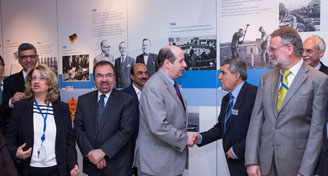SILK-Afghanistan: 10 years of promoting internet connectivity in Afghanistan
Representatives from the Afghan government, the European Commission and NATO came together for a two-day workshop last week to take stock of the achievements of the SILK-Afghanistan programme, assess current needs, and set out a plan to ensure a sustainable future for the initiative.

“SILK-Afghanistan had a big impact on our country because it helps to build capacity, which is one of our biggest challenges,” said the Afghan Deputy Minister for Administrative Affairs in the Ministry of Higher Education, Dr Gul Hassan Walizai. “We should remind ourselves of the starting point. In 2001, there was only one public university, in Kabul, as well as two others, that were not totally functioning. Today, there are 36 public universities, of which 34 are connected to SILK–Afghanistan.”
Marking the importance of the event, which took place on 20 and 21 May at NATO Headquarters, participants included high-ranking Afghan officials from various governmental institutions as well as NATO Assistant Secretary General for Emerging Security Challenges Sorin Ducaru and Dr Lellis Braganza representing the European Commission.
“SILK-Afghanistan is concrete proof of great practical cooperation between NATO and Afghanistan, consolidating the Alliance’s efforts in this partner country’s reconstruction process, and to bring security and stability to the region,” said Ambassador Sorin Ducaru.
The SILK-Afghanistan programme

Funded through the NATO Science for Peace and Security (SPS) Programme, SILK-Afghanistan is the sole source for providing high-speed internet access originally via satellite and now through fibre-optic cable.
Throughout 2014, this flagship project of the SPS Programme continued to cover about 90 per cent of the bandwidth costs for Afghan universities and other academic and governmental institutions. These include 34 Afghan universities as well as the Ministry of Higher Education itself. The programme has also been instrumental in assisting Afghan authorities in developing their educational system.
Today, some 150,000 students – of whom 35 per cent are women – use the internet thanks to SILK-Afghanistan. It is estimated that over two million Afghans have access to the internet.
Last year, Afghanistan became the 19th member country in the TEIN4 network (Trans-Eurasia Information Network, phase 4). This regional academic network provides a dedicated high-capacity internet network between research and education communities in the region and is co-funded by the European Commission.
Ultimately, the aim is for SILK-Afghanistan to be funded under TEIN4 with NATO funding due to come to an end this year. However, NATO funding may be extended for a year to bridge the gap between the handover to the European Union.
SILK programme – timeline
Afghanistan becomes the 19th member country in the TEIN4 network.
